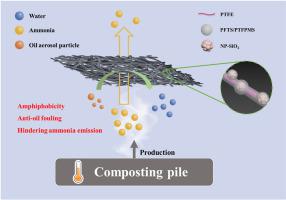Journal of Membrane Science ( IF 8.4 ) Pub Date : 2024-01-11 , DOI: 10.1016/j.memsci.2024.122443
Danrong Cai , Rongze Sun , Yuzhe Zhou , Wentao Yan , Yong Zhou , Congjie Gao

|
Composting is a process of converting potentially harmful organic matter into harmless organic fertilizer through microbial fermentation. This process enables the rational use of resources and represents an embraced technology marked with sustainable development features. Hindering ammonia emissions during composting is vital, as ammonia is a valuable resource and harmful if emitted excessively. Polytetrafluoroethylene (PTFE) membranes are often used as functional covering membranes to prevent ammonia produced by composting from releasing due to its hydrophobicity. However, they are susceptible to oily aerosols in oily composting, which affects microbial decomposition in aerobic composting. Thus, the development of amphiphobic PTFE membrane is necessary and meaningful. For the amphiphobic PTFE membrane, an important issue is the amphiphobic stability of the membrane, especially in the special alkaline environment of composting. Herein, we suggest the use of the polymer to wrap around nanoparticles and PTFE membrane fibers to prepare stable amphiphobic membranes as functional covering membranes for oil-containing composting. Poly(methyl-3,3,3-trifluoropropylsiloxane) (PTFPMS) and 1H, 1H, 2H, 2H-perfluorodecyltrichlorosilane (PFTS) entangled with each other and then wrapped the nanoparticles and membrane fibers to form stable amphiphobic membranes with high roughness and low surface energy. The prepared membrane had high liquid repellency to water (~152.8°), diiodomethane (~127.5°), and n-hexadecane (~127.0°). This membrane also possessed a high anti-oil fouling. Moreover, the membrane amphiphobicity exhibited a high stability. This is attributed to the stable fixation of nanoparticles on PTFE membrane fibers with PFTS/PTFPMS. Therefore, the amphiphobicity of the membrane was not affected by ammonia. As for the ammonia filtration efficiency, the amphiphobic membrane had a filtration efficiency of 77.4 % within 10 min, an increase of 6.8 % compared to the PTFE membrane, demonstrating the potential of the membrane we developed toward hindering ammonia emission. This work provides a new way of developing high-performance membrane for the oily composting process.
中文翻译:

双疏PTFE膜作为功能性覆盖膜,可阻止堆肥过程中氨的排放
堆肥是通过微生物发酵将潜在有害的有机物转化为无害有机肥料的过程。这一过程实现了资源的合理利用,是一种具有可持续发展特征的公认技术。阻止堆肥过程中氨的排放至关重要,因为氨是一种宝贵的资源,如果排放过多,则会造成危害。聚四氟乙烯(PTFE)膜因其疏水性而常被用作功能性覆盖膜,以防止堆肥产生的氨释放。然而,它们在含油堆肥中容易受到油性气溶胶的影响,从而影响好氧堆肥中的微生物分解。因此,开发两疏PTFE膜是必要且有意义的。对于双疏PTFE膜来说,一个重要的问题是膜的双疏稳定性,特别是在堆肥的特殊碱性环境中。在此,我们建议使用聚合物包裹纳米颗粒和PTFE膜纤维来制备稳定的两疏膜作为含油堆肥的功能覆盖膜。聚(甲基-3,3,3-三氟丙基硅氧烷)(PTFPMS)和1H,1H,2H,2H-全氟癸基三氯硅烷(PFTS)相互缠结,然后包裹纳米颗粒和膜纤维,形成稳定的双疏膜,具有高粗糙度和低表面能。制备的膜对水(~152.8°)、二碘甲烷(~127.5°)、正十六烷(~127.0°)具有较高的拒液性。该膜还具有高抗油污能力。此外,膜的双疏性表现出较高的稳定性。这归因于使用 PFTS/PTFPMS 将纳米粒子稳定固定在 PTFE 膜纤维上。因此,膜的双疏性不受氨的影响。至于氨过滤效率,双疏膜在10分钟内的过滤效率为77.4%,与PTFE膜相比提高了6.8%,展示了我们开发的膜在阻碍氨排放方面的潜力。这项工作为开发用于含油堆肥过程的高性能膜提供了一种新方法。































 京公网安备 11010802027423号
京公网安备 11010802027423号